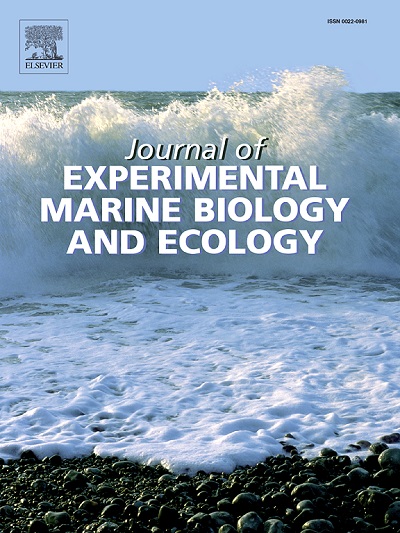濒危白鲍鱼(haaliotis sorenseni)的代谢和缺氧耐受性:保护和恢复工作的意义
IF 1.8
3区 生物学
Q3 ECOLOGY
Journal of Experimental Marine Biology and Ecology
Pub Date : 2025-06-02
DOI:10.1016/j.jembe.2025.152107
引用次数: 0
摘要
白鲍鱼(Haliotis sorenseni)是一种濒临灭绝的海洋腹足类动物,尽管渔业关闭并处于保护状态,但其数量仍没有恢复的迹象。为了更好地了解该物种的能量需求、耐缺氧能力和关键栖息地,我们测量了在不同环境氧浓度和温度下,人工饲养的H. sorenseni的氧气消耗率,并与更常见的H. rufescens进行了比较。我们发现sorenseni的代谢率相对较低,这可能会导致生长缓慢,阻碍恢复努力。我们还发现,H. sorenseni和H. rufescens似乎在一定程度上符合环境氧条件,通过降低代谢来应对日益增加的缺氧,同时仍然保持有氧范围,直到达到临界氧浓度(Pcrit),在这一点上它们成为氧限制。对于表现出这种关系的物种,测定P90、P75、P50和P25(耗氧量为静息代谢率的90%、75%、50%和25%时的溶解氧值)以及Pcrit和供氧能力,可以为比较物种和个体之间的缺氧敏感性提供有用的指标。这些指标的可变性表明,为了恢复外植,在人工繁殖和饲养的sorenseni个体存在潜在的适应度差异。高温还导致sorenseni的P90、P75、P50、P25和Pcrit升高,并减少了析因需氧范围,揭示了高温和低氧的潜在复合效应。因此,我们的研究结果提供了一套生理指标,用于测试人工饲养鲍鱼的健康和适应性,并可以帮助选择合适的外植地点。本文章由计算机程序翻译,如有差异,请以英文原文为准。
Metabolism and hypoxia tolerance of the endangered white abalone (Haliotis sorenseni): Implications for conservation and restoration efforts
The white abalone, Haliotis sorenseni, is an endangered marine gastropod that has shown no signs of population recovery despite fishery closure and protective status. To better understand the energetic demands, hypoxia tolerance, and critical habitat of this species, we measured oxygen consumption rates over a size range of captive-reared H. sorenseni at different environmental oxygen concentrations and temperatures in comparison to the more common red abalone, H. rufescens. We found that H. sorenseni has a relatively low metabolic rate that likely contributes to generally slow growth that can hamper recovery efforts. We also discovered that both H. sorenseni and H. rufescens appear to partially conform to ambient oxygen conditions by lowering their metabolism to deal with increasing hypoxia while still retaining an aerobic scope until reaching a critical oxygen concentration (Pcrit), at which point they become oxylimited. For species exhibiting such relationships, determining the P90, P75, P50, and P25 (dissolved oxygen value at which oxygen consumption is 90 %, 75 %, 50 %, and 25 % of resting metabolic rate), as well as the Pcrit and oxygen supply capacity, can provide useful metrics to compare hypoxia sensitivities among species and individuals. Variability in these metrics suggest potential fitness differences for H. sorenseni individuals spawned and raised in captivity for restoration outplanting. Higher temperatures also led to an increase in P90, P75, P50, P25, and Pcrit and decrease in factorial aerobic scope for H. sorenseni, revealing the potential compounding effects of high temperature and low oxygen. Our results thus provide a suite of physiological metrics on which to test the health and fitness of captive-reared abalone and can help inform selection of appropriate outplanting sites for endangered H. sorenseni.
求助全文
通过发布文献求助,成功后即可免费获取论文全文。
去求助
来源期刊
CiteScore
4.30
自引率
0.00%
发文量
98
审稿时长
14 weeks
期刊介绍:
The Journal of Experimental Marine Biology and Ecology provides a forum for experimental ecological research on marine organisms in relation to their environment. Topic areas include studies that focus on biochemistry, physiology, behavior, genetics, and ecological theory. The main emphasis of the Journal lies in hypothesis driven experimental work, both from the laboratory and the field. Natural experiments or descriptive studies that elucidate fundamental ecological processes are welcome. Submissions should have a broad ecological framework beyond the specific study organism or geographic region.
Short communications that highlight emerging issues and exciting discoveries within five printed pages will receive a rapid turnaround. Papers describing important new analytical, computational, experimental and theoretical techniques and methods are encouraged and will be highlighted as Methodological Advances. We welcome proposals for Review Papers synthesizing a specific field within marine ecology. Finally, the journal aims to publish Special Issues at regular intervals synthesizing a particular field of marine science. All printed papers undergo a peer review process before being accepted and will receive a first decision within three months.

 求助内容:
求助内容: 应助结果提醒方式:
应助结果提醒方式:


